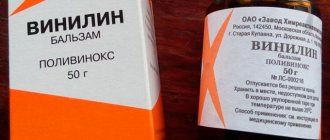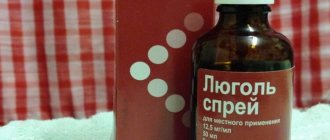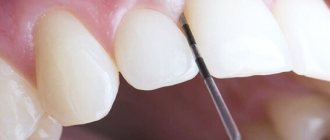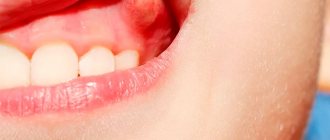Author: Brodsky Sergey Evgenievich Deputy Chief Physician, Candidate of Medical Sciences in the specialties: dentistry and medical microbiology Many patients face problems such as bleeding, inflammation, gingivitis, periodontitis, stomatitis and other diseases that cause loose gums. To treat them, strengthening of the gums is required. How to strengthen gums at home? Which product is best for strengthening gums? How to strengthen loose gums? How to strengthen your gums correctly? First, let's figure out what causes this problem:
- Incorrect and untimely oral care.
- Poor nutrition.
- Lack of vitamins.
- Problems with the gastrointestinal tract.
How to determine if there are problems with your gums?
You can observe the following picture of the disease:
- swelling of the gums;
- redness;
- bleeding
Such symptoms without proper therapy lead mainly to tooth extraction. To avoid this, it is necessary to urgently begin treatment. Treating gums at home is a proven method that works quickly, and you can delight others with a beautiful and healthy smile.
- Causes of gum inflammation
- Methods for self-treatment of gums at home
- Hydrogen peroxide solution for rinsing
- Oak bark for gums
- Baking soda rinse
- Herbal decoction
- St. John's wort infusion
- Aloe - compress
- Saline solution
- Chamomile and calendula
- Infusion of pine buds
- Propolis - alcohol tincture
- Calamus root
- Honey + Salt
- Black radish
- Linden flowers and oak bark
- Nettle leaf decoction
Combination of rinses and application gel –
The selection of rinse aid and gel is carried out in such a way that both antimicrobial and anti-inflammatory effects are equally realized.
Those. if you choose a rinse with antimicrobial components - such as chlorhexidine, hexitidine, cetylpyridine, triclosan, then in parallel you need to use a gum gel containing anti-inflammatory components (this can be choline salicylate, phenyl salicylate, methyl salicylate, etc.). But if you use a rinse primarily with anti-inflammatory components (for example, Parodontocid mouthwash), then you need to choose a gum gel that contains an antiseptic and/or antibiotic. Such gels include Perio-Aid, PRESIDENT Effect gel and others. For more information about anti-inflammatory gels for the treatment of gum inflammation and patterns of their use, read the article:
→ Rating of the best gels for gum inflammation
Inflammation after tooth extraction - treatment
When there is no way to save a tooth, there is only one option left - to remove it. When removing, anesthesia is used, when its effect wears off, the tooth socket may ache, if the pain does not disappear within 2-3 days and painkillers do not help, most likely the inflammatory process of the tooth socket has begun. What could be causing it:
- Injury during tooth extraction;
- Foreign particles entering the hole cause inflammation;
- Improper hygiene;
- Infection in the hole.
To relieve inflammation after tooth extraction, you should not self-medicate; in this case, you should definitely consult a doctor.
Self-medication in this case can lead to the development of abscesses and sepsis. The doctor will correctly select the right antibiotic and dosage of the medicinal drug, an antiseptic solution for rinsing the mouth.
Mouth rinses may be unsafe -
You may notice that the instructions for rinses with antiseptics and antibiotics (at least from some manufacturers) recommend using them for 3-4 weeks, and in some cases even up to 1-2 months. It is absolutely impossible to follow such recommendations, because... Long-term use of antiseptics radically changes the composition of the oral microflora, and not for the better. Pathogenic microflora tends to get used to antiseptics (as they say, the fittest survive), and therefore, after the end of the use of antiseptics, the rate of destruction of the attachment of teeth to the bone and gums can only increase. Therefore, the course of rinsing with antiseptics should not last more than 10-12 days.
In addition, clinical studies (source) revealed that after just 7 days of rinsing the mouth with chlorhexidine, the ratio of microflora in the oral cavity changed in such a way that strains of pathogenic bacteria that produce large amounts of lactic acid received an advantage. This leads to a shift in the pH of the oral fluid to the acidic side, to a decrease in the buffer capacity of saliva and a decrease in its ability to neutralize lactic acid, which is secreted by cariogenic bacteria. Thus, the risk of developing dental caries increases.
Important for patients with cardiovascular pathology -
Several reputable scientific studies have shown that chlorhexidine interferes with the ability of oral bacteria to convert nitrates (found in foods) into nitrites. This bacterial activity is called “nitrate-reducing” and is one of the mechanisms for maintaining normal blood pressure. Normally, nitrites entering the blood help lower blood pressure and, accordingly, a decrease in their production will lead to an increase in blood pressure.
This is primarily important for patients who already have chronic cardiovascular pathology. This information is confirmed by the clinical study “The increase in plasma nitrite after a dietary nitrate load is markedly attenuated by an antibacterial mouthwash. Nitric Oxide" (2008), authors – Mirco Govoni, Emmelie Å. Jansson, and others. If you wish, you can familiarize yourself with this study using the link above, for example, using a browser translator.
Why does it occur in men?
Increased loads cause a salty taste in the mouth of men constantly engaged in physical labor or training. During intense movements, blood pressure rises and blood circulation in all organs and systems increases. The blood is filled with iron and sodium ions, so the taste of salt on the lips and in the mouth may well be felt.
In addition, sweat gets on your lips, and if you accidentally lick it off, you can feel a salty bitterness on your tongue.
In some cases, a specific taste in the mouth in men is associated with the development of prostatitis, but it is not regarded as an important symptom due to its mild severity.
If a man feels a salty taste on his tongue in the morning, this may indicate a stormy evening yesterday with the consumption of a large amount of alcoholic beverages.
Alcohol dehydrates the body. Its breakdown products in the blood cause intoxication and dehydration. To normalize the water-salt balance, you need to drink at least 2 liters of liquid (mineral water, juices, compotes, rosehip decoction, clean water).
What you don't need to rinse your mouth with -
Many patients who try to be treated at home sometimes treat their gums with hydrogen peroxide.
Of course, hydrogen peroxide is a good antiseptic, and it is excellent in treating many infectious processes (for example, purulent wounds). It can also be used in dentistry, but not for rinsing the mouth, but for rinsing periodontal pockets with a syringe. When hydrogen peroxide comes into contact with any organic matter, it begins to foam, releasing atomic oxygen. When rinsing periodontal pockets, 3% peroxide is drawn into a syringe and the sharp edge of the needle is broken off (so as not to pierce the gum). Then the blunt end of the needle is inserted along the tooth root into the lumen of the periodontal pocket and washed under pressure. As a result, all infection and pus are washed out of the pockets.
But when rinsing the mouth, peroxide will react most quickly only with oral fluid, and other than a full mouth of foam, you will not get any effect. You won’t be able to rinse your pockets with a syringe at home yourself. For this you need a doctor, because... if you suddenly inject peroxide not into the lumen of the periodontal pocket, but directly into the soft tissue of the gums, you will receive a severe chemical burn with subsequent necrosis.
Gargling with infusions of medicinal herbs –
Many patients prepare their own rinse solutions by brewing medicinal herbs such as chamomile or oak bark. Such infusions actually have a good astringent effect, moderate anti-inflammatory, and also a weak antiseptic effect. And this can really help reduce swelling and bleeding of the gums, but such herbal infusions also have one big disadvantage.
The fact is that self-brewed herbal infusions contain a lot of pigments and tannins, which are very quickly deposited on the teeth in the form of pigment plaque. This plaque forms very quickly, and it will serve as a good basis for the already microbial plaque to attach to the surface of the teeth. But it is microbial plaque and tartar that cause gum inflammation. Therefore, if you use solutions with herbs, it is better in the form of ready-made rinses (since manufacturers remove from them all pigments that stick to tooth enamel).
Symptoms
Acute periodontitis is characterized by an attack of severe pain, during which swelling and swelling of the gums is observed, but the root top of the tooth is not yet destroyed. The chronic course of periodontitis practically does not manifest itself and is often asymptomatic; occasionally there is pain when biting. This stage of the disease can only be identified by contacting a dentist, who will make an accurate diagnosis using x-rays.
The acute form of the disease will not show any significant changes in the tooth area, but the chronic form will manifest itself in the appearance of a purulent sac, an abscess at the top of the root. In order not to cause damage to the oral cavity and save the tooth, long-term treatment will be required, which will take quite a lot of time, but it is also worth noting the fact that with modern medicine this process will be painless.
In what cases are rinses ineffective?
The author of the article has 10 years of experience as a “periodontologist” (documents on advanced training of the state standard in the “Parodontology” program - can be viewed in the editorial section), and we would like you to listen to our experience. The fact is that knowing what to rinse your mouth with when your gums are inflamed is not enough to cure their inflammation (24stoma.ru). Various mouthwashes (even the strongest ones), anti-inflammatory gels are only secondary means.
There are 2 main types of gum inflammation – gingivitis and periodontitis. Gingivitis is the initial stage of inflammation, the main symptoms of which are: swelling, redness or bluishness of the gums, pain and bleeding when brushing teeth, bad breath (Fig. 3-4). With periodontitis, these symptoms are accompanied by mobility of teeth, suppuration from periodontal pockets, destruction of bone tissue around the teeth, and in later stages, changes in the position of the teeth (Fig. 5).
Gingivitis and mild periodontitis –
The cause of gum inflammation in both cases is soft microbial plaque, as well as hard supra- and subgingival dental deposits (Fig. 3-5). This is the main cause of inflammation, which is a consequence of insufficient oral hygiene. And the most important part of treatment should not be to reduce symptoms, but to eliminate the real cause of gum inflammation. And for this purpose, dental plaque is removed by a dentist (usually this is done using ultrasound).
Antiseptic rinses act only on the most superficial layer of microbial plaque or tartar. They do not act on the deeper layers, which also consist of pathogenic bacteria, and therefore the use of antiseptics does not lead to complete “disinfection”. Therefore, rinsing with antiseptics and gels for gums (without removing dental plaque) lead only to temporary improvement, and the inflammation in this case will be constant chronic - with periodic exacerbations.
Television advertising very actively promotes all sorts of products for gums, but it does not say that the main treatment is precisely the removal of dental plaque. Remember that a mild form of gingivitis can unnoticeably turn into a severe form of periodontitis if you try to treat the inflammation only with antiseptic rinses and anti-inflammatory gels - without periodic removal of dental plaque by the dentist.
→ How to properly treat gingivitis → Treatment regimens for periodontitis
Toothpastes for gum inflammation -
In complex therapy for the treatment of gum diseases, you can use not only rinses and gel applications, but also special anti-inflammatory toothpastes for gums, which will reduce bleeding and swelling of the gums even faster. Some of these pastes are also suitable for preventing inflammation. We hope that our article on the topic: How to rinse the mouth with gum inflammation was useful to you!
Sources:
1. Dental education of the author of the article, 2. Based on personal experience as a periodontist, 3. PubMed.gov scientific research base, 4. “Optimization of conservative treatment of patients with periodontitis” (Komleva A.S.), 5. Composition of products taken from official websites manufacturers.
Treatment
When the pain can no longer be tolerated and medications do not help, you should immediately visit the dentist. When examining the patient, the doctor prescribes the necessary treatment, which will not be quick, but will lead to a complete recovery. The main goal of any dentist is to save the tooth.
During the initial examination, an x-ray is taken, with its help you can see the most complete picture of the disease. When the source of inflammation is found, you can begin to determine the form of the disease and treat the root. Today in dentistry, anesthesia is used not only for tooth extraction, as it was in Soviet times; modern drugs are mostly hypoallergenic, non-addictive, do not have a large list of contraindications, and can also be used in the treatment of children's teeth.
When treating a tooth root, the doctor ensures maximum comfort for the patient, anesthetizes the treatment site, then opens the tooth root and cleans it of purulent accumulation, then a special medicinal mixture is placed into the hole. Having covered the top with a special gasket, the doctor closes the tooth with a temporary filling.
Next, you need to wait a few days for the inflammation to subside. You need to wait about 5-7 days and take another picture to confirm that the inflammatory process has stopped. Next, the cleaned dental canals are re-filled and a new temporary filling is installed. Filling protects against new infections, which contribute to inflammation.
After three days, a final follow-up visit is made to the doctor, who, after examining the patient, making sure that there are no inflammatory processes and successful treatment, closes the tooth with a permanent filling and polishes it.
Subsequently, a restoration process occurs, during which the gums may still be sore, the tooth may even become loose, but after a while, the unpleasant symptoms will disappear. To avoid recurrent disease of the root of the treated tooth, the doctor’s appointment is repeated six months later.










